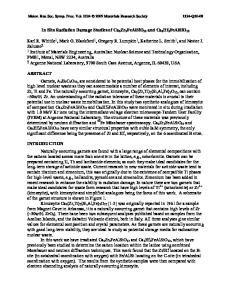Raman Studies on Potential substrate Materials of Sr(Al 1/2 Ta 1/2 )O 3 and Sr(Al 1/2 Nb 1/2 )O 3 For HTSC
- PDF / 317,062 Bytes
- 6 Pages / 414.72 x 648 pts Page_size
- 47 Downloads / 399 Views
MATERIALS
OF
Ruiwu Tao, A.R. Guo, C.-S. Tu, I. Siny and R.S. Katiyar, Department of Physics, University of PuertoRico, Rio Piedras,PR 00931-3343; Ruyan Guo and A.S. Bhalla, MaterialsResearch Laboratory,Penn. State University, University Park, PA 16802
Complex oxide perovskites, namely strontium aluminum tantalum oxide (SAT) and strontium aluminum niobium oxide (SAN) were recently investigated to be potential substrate materials for HTSC films in microwave applications. Single crystals were prepared by laser heated pedestal growth technique (LHPG). We report Raman vibrational spectrum studies on them for the first time. Order-disorder effects of (Al,Ta) and (Al, Nb) sites were studied with particular interests by comparing Raman spectra of single-crystal samples with ceramic samples. Influences of B sites (Ta and Nb) on 0-0 modes are discussed in relation to their dielectric properties.
I. Introduction High temperature oxide superconducting (HTSC) materials have drawn much interest from scientists in various fields. The suitable substrate material for HTSC growth is also an important subject to many researchers. Strontium aluminum tantalum oxide (SAT) and strontium aluminum niobium oxide (SAN) are potential microwave dielectric substrate materials for thin film of HTSC devices. It is believed that both SAT and SAN belong to the mixed perovskite family. It is also known that they do not have ferroelectric properties. One of the requirements of HTSC substrate is that the material should have a low dielectric loss at microwave frequencies (- 10 GHz) and a low dielectric constant. In perovskite materials, the B-site order-disorder behavior is believed to have influence on the dielectric properties and especially on the dielectric loss. It is possible that some low frequency modes may have characteristics which are useful to understand the dielectric loss mechanism in these materials. SAT and SAN samples in ceramic form are known to have a 1:1 ordered cubic structure with a doubled perovskite unit cell111 . On the other hand, their LHPG grown crystals are best described as disordered, but twin-free, simple cubic perovskite structures. The ordered ceramic samples have Fm3m space group symmetry. Factor groups of each site are Sr(Td), B'(Oh), B"(Oh), and O(C 4v). The normal vibrational modes are ( = Sr 0 =0 O,@ =B'orB" FtotaI = A18 + Eg + T 18 + 5T1, + 2T 2g + F 2 u. The Raman active modes are, FR.man = A1g(O-O) + Eg(O-O) + 2T 2g(Sr-0), Fig. 1 The unit cell of SAN and SAT where the atoms that participate in the motion of with Fm3m symmetry. particular symmetry are shown in the parenthesis. 357 Mat. Res. Soc. Symp. Proc. Vol. 397 © 1996 Materials Research Society
The crystal structure and some normal modes of vibrations are shown in Figs. l and 2 respectively. From the mode classification, it is evident that the atoms at B sites are not involved in any Raman active normal vibrational motions.
A18
E
T28
O =Oxigen = B' or B" Fig. 2 The Raman active normal vibrational modes of a free oxygen octahedron around the B ion
Data Loading...











